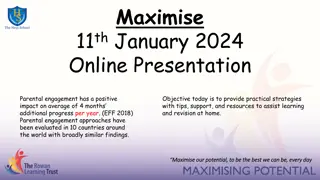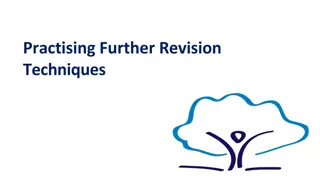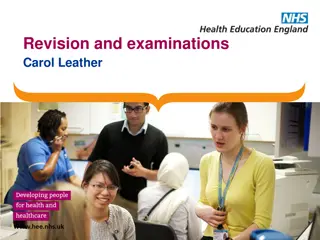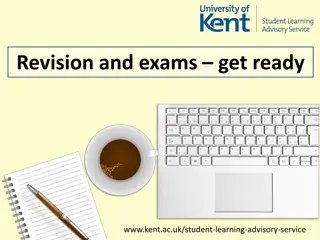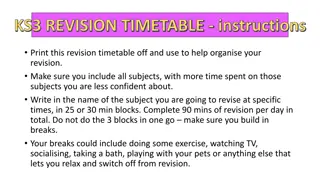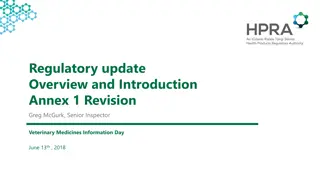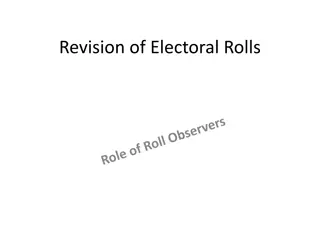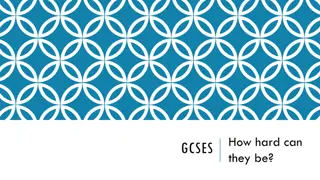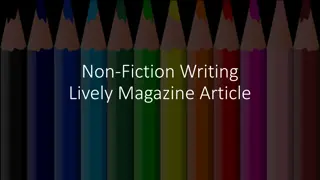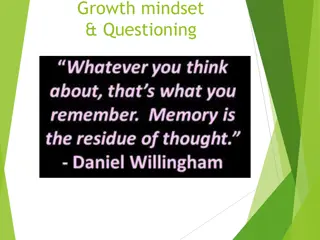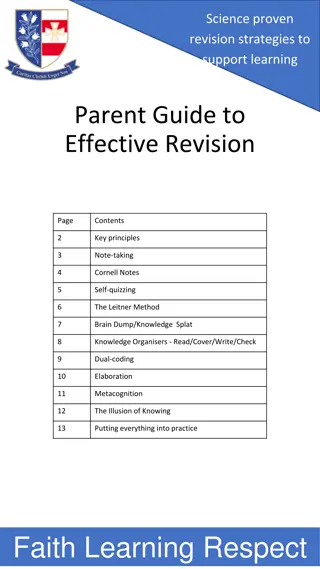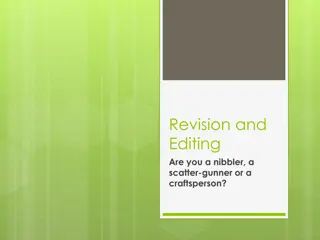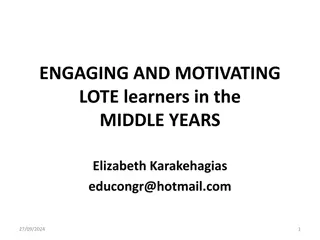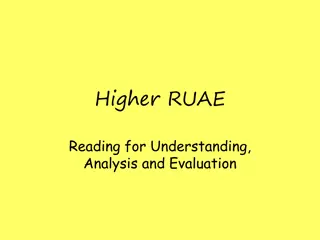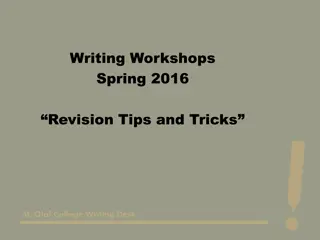Effective Flashcard Revision Techniques for Students
Explore tips and tricks for creating and utilizing flashcards effectively to enhance learning and retention. Discover the difference between passive and active revision methods, along with examples of active techniques such as mind maps and answering questions. Step-by-step guidance on making flashcards for cell biology is provided, emphasizing the importance of engaging with the material actively. Start building your revision folder with colorful flashcards today!
Download Presentation

Please find below an Image/Link to download the presentation.
The content on the website is provided AS IS for your information and personal use only. It may not be sold, licensed, or shared on other websites without obtaining consent from the author.If you encounter any issues during the download, it is possible that the publisher has removed the file from their server.
You are allowed to download the files provided on this website for personal or commercial use, subject to the condition that they are used lawfully. All files are the property of their respective owners.
The content on the website is provided AS IS for your information and personal use only. It may not be sold, licensed, or shared on other websites without obtaining consent from the author.
E N D
Presentation Transcript
RESOURCES REQUIRED Coloured card Scissors Coloured pens (optional) Students will need subject revision lists/exercise books
HOW TO REVISE FLASH CARDS TIPS AND TRICKS TO HELP YOU LEARN HOW TO REVISE
PASSIVE VS ACTIVE Reading notes and highlighting key information make us FEEL like we re doing revision BUT it requires very little brain power! We say it is PASSIVE. In order to remember things long term, we need to DO something more ACTIVE.
EXAMPLES OF ACTIVE REVISION TECHNIQUES Mind Maps Flash Cards Answering Questions and checking your answers Teaching someone else
THIS LESSONS FOCUS FLASH CARDS How to make them Step 1 Pick a topic to revise. Find the Key Words or Key Facts for this topic Step 2 Think of colour coding your cards. A different colour for each subject for instance? Step 3 On one side of the card write the Key Word, on the other side write the definitions/meanings. You could also write a question on one side and an answer on the other.
YOUR TURN... You are going to make a set of Flashcards for Cell biology On one side of the card write the part of the topic e.g. animal Cell structure On the other side of the card write down what c means. Include an example if this helps you Add diagrams or pictures if any come to mind e.g.
Keyword 1. Carbohydrate Example Starch Description Needed for energy 2. Protein Growth and repair Meat, Fish 3. Lipid Store of energy and insulation Oils 4. Enzymes carbohydras e. Breaks down large insoluble molecules into smaller soluble molecules. 5. Benedicts A blue solution Tests for glucose. Turns brick red if positive.
GREAT EXAMPLES... The best examples have words and pictures!
WHAT NEXT? For the rest of this week you will be doing a set of Flash cards in each lesson for a different topic. Pick the part of the topic you are finding it most difficult to revise for Find the Revision checklists for those subjects on google classroom or take a paper copy. Homework Get a revision folder and complete a set of Flash Cards for the topic we have been working on. I want to see your Revision Folder and will expect to see it bursting with Flash Cards!
Year 8 Health and Lifestyle KEY FACTS KEY WORDS 1 A balanced diet contains the correct quantities of all the nutrients needed to remain healthy. Essential substance that your body needs to survive, provided by food. 1 Nutrient A nutrient that provides energy. 2 Carbohydrate 2 The seven key nutrients are carbohydrates, lipids, proteins, vitamins, minerals, water and fibre. A nutrient that provides a store of energy and insulates the body, 3 Lipid 3 Food tests can identify the nutrients in different foods. To prepare a food sample for testing crush the food with a pestle and mortar, add a few drops of distilled water and mix well. To test for starch add a few drops of orange-yellow iodine solution. The solution will become dark blue-black if starch is present. Nutrient used for growth and repair. 4 Protein Essential nutrients needed in small amounts for a healthy body. 5 Vitamins and minerals 4 Provides bulk to food which helps to keep it moving through the digestive system. 6 Fibre 5 To test for sugar add a few drops of blue Benedict s solution and heat in a water bath. The solution will turn orange-red if sugar is present. To test for lipids add a few drops of ethanol, shake the test tube and pour the ethanol into a test tube of water. If the solution turns cloudy, the food contains lipids. To test for protein add a few drops of blue copper sulphate solution followed by a few drops of sodium hydroxide solution. If the solution turns purple, the food contains protein. Malnourishment can result n health problems resulting from being over or under weight. Being underweight is associated with a poor immune system, lack of energy, tiredness and a lack of vitamins and minerals. Being overweight is associated with heart disease, stroke, diabetes, some cancers. Extreme case of not eating enough food. 7 Starvation 6 Extremely overweight. 8 Obese A lack of essential minerals which often leads to health problems. 9 Deficiency 7 Group of organs that work together to break down food. 10 Digestive system 8 Process where large molecules are broken down into small molecules. 11 Digestion Tiny projections on the wall of the small intestine that increase the surface area for absorption of nutrients. A substance which speeds up a chemical reaction without being used up itself. 12 Villi 13 Catalyst 9 Different people require different amounts of energy from their diet, depending on age and how active they are. Biological catalysts which can break large molecules down into smaller ones. 14 Enzymes 10 Enzymes are biological catalysts. Different enzymes break down different nutrient molecules into small molecules which can be absorbed: Carbohydrase breaks carbohydrates down into sugar molecules. Protease breaks proteins down into amino acids. Lipase breaks lipids down into fatty acids and glycerol. Medicinal drugs may have unwanted side effects as well as medical benefits. Recreational drugs usually have no health benefits and in some cases are harmful. Many recreational drugs are illegal, e.g. cocaine, heroin, cannabis and ecstasy. Some recreational drugs, such as alcohol and tobacco are legal but can still be harmful. A substance which breaks fat into small droplets. 15 Bile Chemical substance which affects the body s function. 16 Drug A drug that that has a medical benefit to health. 17 Medicinal drug 11 A drug which is taken for enjoyment. 18 Recreational drug The drug found in alcoholic drinks. 19 Ethanol A drug that slows down the bod s reactions by slowing the nervous system. 20 Depressant A drug that speeds up the body s reactions by speeding up the nervous system. 21 Stimulant A need to keep taking a drug in order to feel normal. 22 Addiction Quantity of drink containing the equivalent of 10 ml of pure ethanol. 23 Unit of alcohol
Year 8 Health and Lifestyle DIGESTIVE SYSTEM DIGESTIVE ENZYMES Protease breaks proteins down into amino acid molecules. Carbohydrase breaks carbohydrates down into sugar molecules. Lipase breaks lipids down into glycerol and fatty acid molecules.
HOW TO REVISE FROM FLASH CARDS Start by reading the definitions/answers and see if you can guess the word/question If you get them right, put them in a pile on the RIGHT (as in you got them RIGHT! ) If you get them wrong, put them in a pile on the LEFT (as in you still have these LEFT to learn! ) Go back the pile on the LEFT. Try them again and see if you get them right this time Extension start with the word/question and see if you know the definition or answer off by heart!




